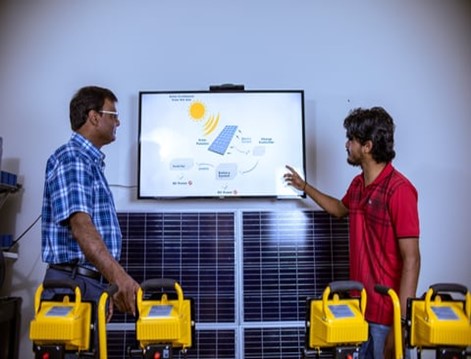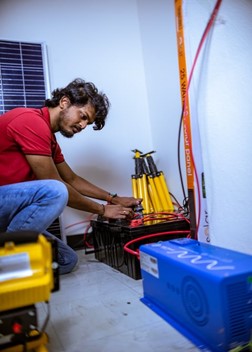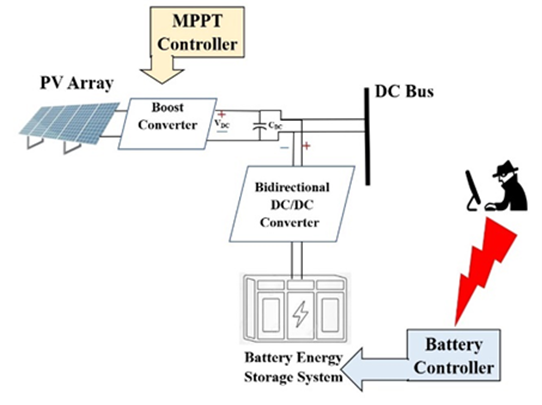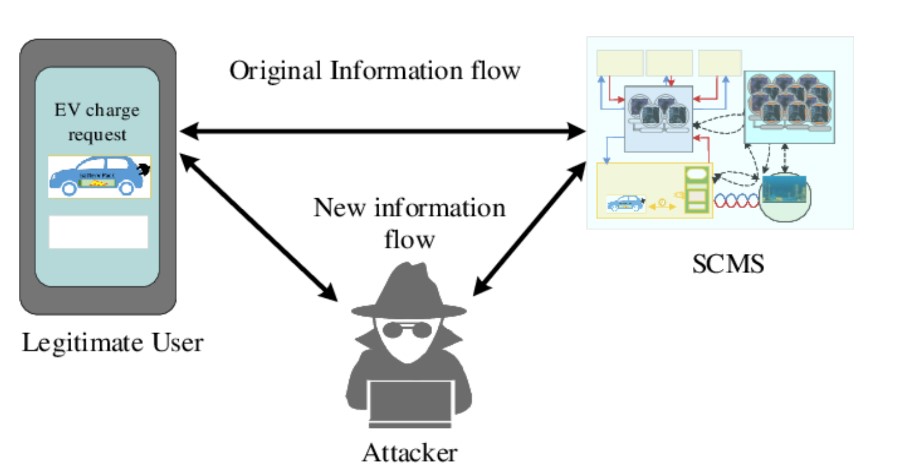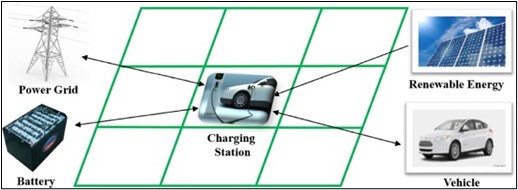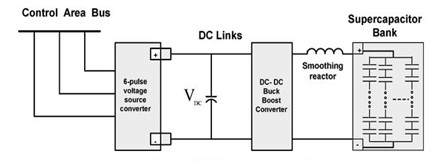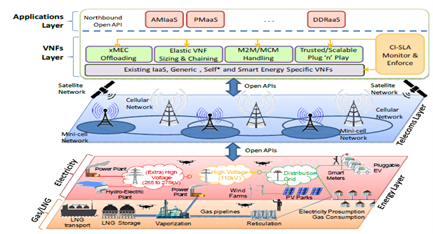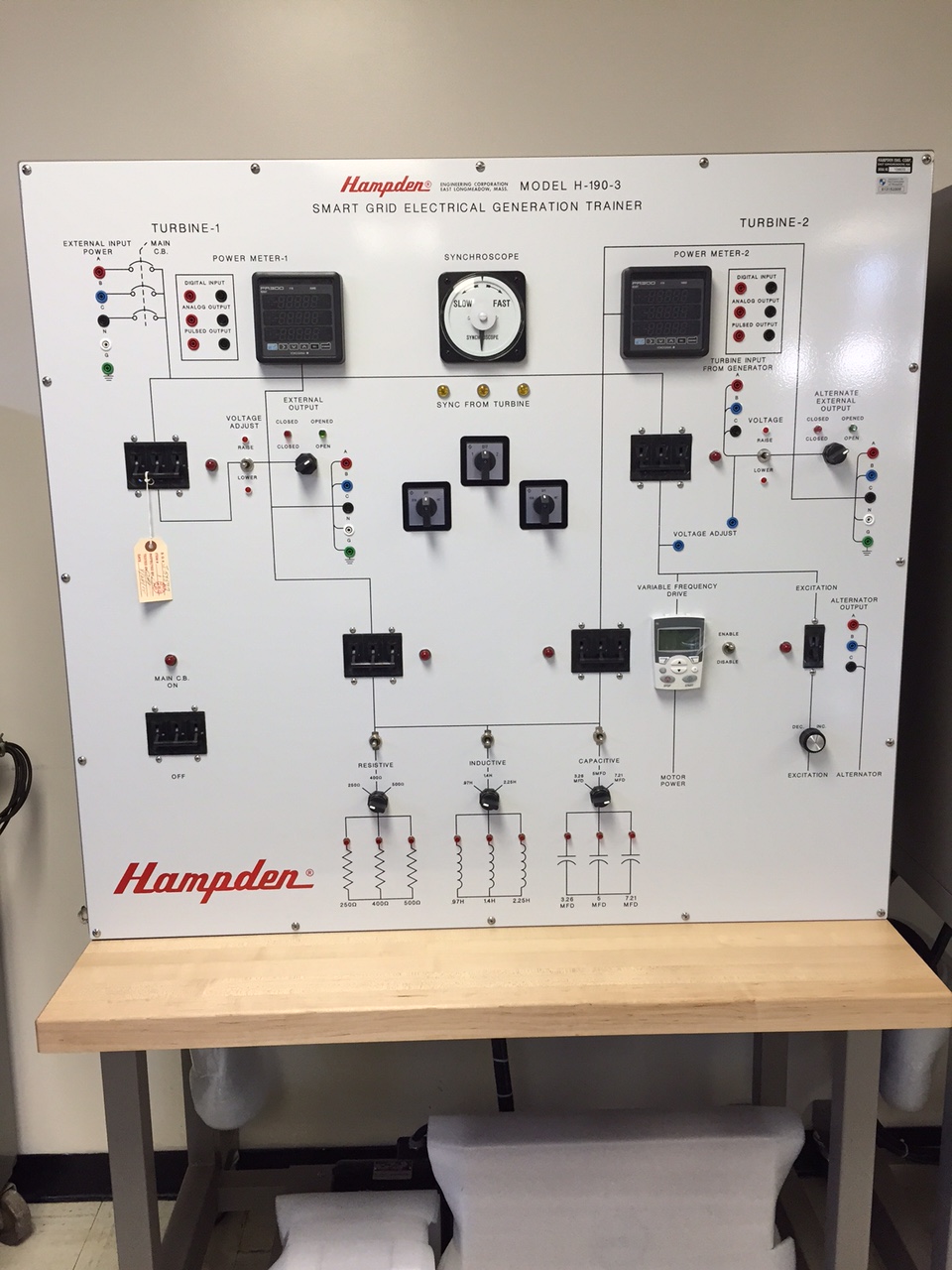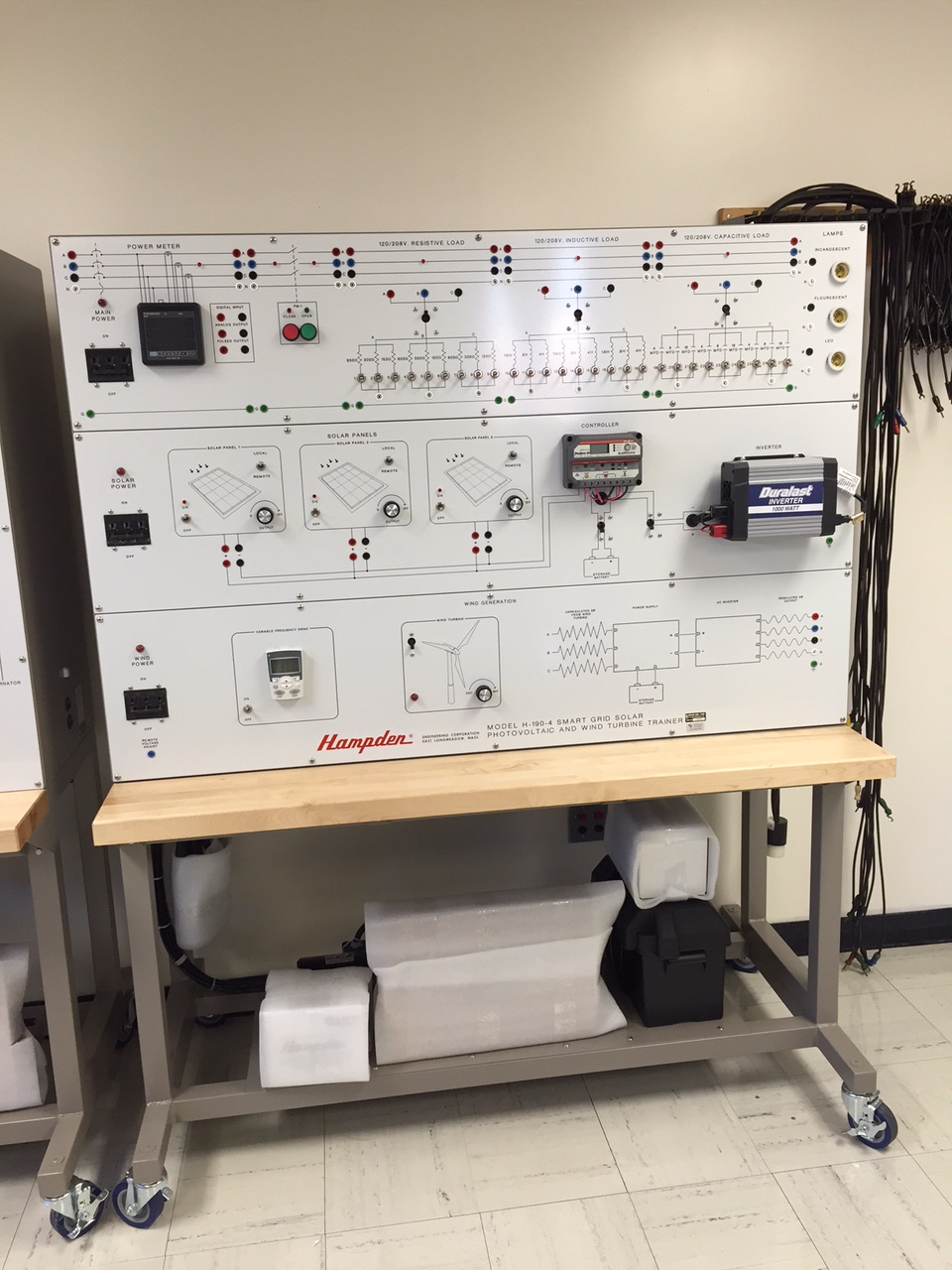EECE
Current Research
The EPES Lab currently deals with the following research.
Cyber Resilient 5G Enabled Smart Inverter for Solar Photovoltaic (PV) System
Smart intelligent inverters, the crucial component in the PV systems converts the generated DC power source into AC power usable by the connected loads or the utility grid. These smart intelligent inverters communicate with the SCADA system and 5G network can further enhance the capabilities of the inverters by providing reliable and faster communication with the SCADA. However, as these inverter systems become interconnected and reliant on communications, they introduce significant cybersecurity challenges. They become the potential targets for cyber intruders who can manipulate the system performance that can lead to catastrophic disasters. In this regard, our research is focused on the development of advanced intelligent controller methods for the inverters that can enhance the capabilities to maintain a reliable and stable power transfer. We further introduce the latest Artificial Intelligence (AI) and Machine Learning (ML) techniques for designing the controller and for the detection and mitigation of cyber-intrusions on a smart intelligent inverter. Moreover, our research focuses on the use of the evolving communications like 5G, 6G networks to make the power grids more sophisticated and advanced that helps to maintain a safe, reliable, and stable power to the connected loads.
5G IoT Integration into Cybersecure EV Charging Stations
With the growing electric vehicles market, we are working on EV charging stations to help combat this fluctuation. We are designing this system with cybersecurity at the root of the system to help prevent problems in the interconnection of the IoT aspect of this system. In addition to this security, we are integrating modern protocols including 5G to be on the leading edge of research. This system should safeguard against cyber threats, guaranteeing safe and reliable transactions between the station, the vehicle, and the electric grid. Overall, this research focuses on the integration of cyber security, 5G, and smart features into EVs and their charging stations to help facilitate the growing use of EVs and the demand on the power grid.
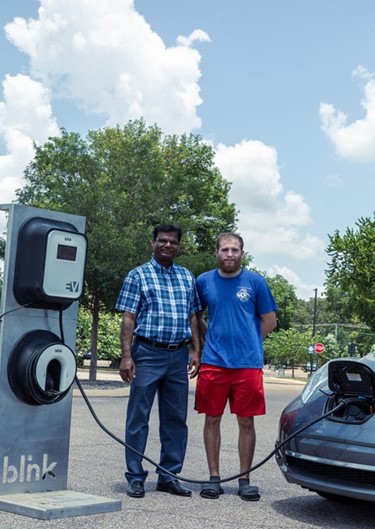
Dynamic Wireless Charging of Electric Vehicles
One major drawback of electric vehicle (EV) charging stations is their limited availability and uneven distribution, which can lead to inconvenience and range anxiety for EV drivers, especially in areas with sparse infrastructure. Additionally, the charging time required for electric vehicles can be significantly longer, posing a challenge for drivers in need of quick recharges. To overcome this problem, dynamic wireless charging (DWC) technology can be used. There are two types of DWC systems, namely road coil to vehicle charging and vehicle-to-vehicle (V2V) charging. DWC addresses range anxiety in EV owners by enabling continuous charging while driving, ensuring uninterrupted travel flexibility. This technology also promotes the adoption of smaller battery sizes, reducing vehicle weight and cost while enhancing energy efficiency and sustainability. However, DWC scheme faces challenges due to lateral misalignment that occurs when the primary and secondary coils fail to align properly, reducing power efficiency and risking accidents. This research aims to developing suitable controllers including artificial intelligence (AI) based controllers to compensate for misalignment issues in both types of DWC systems.
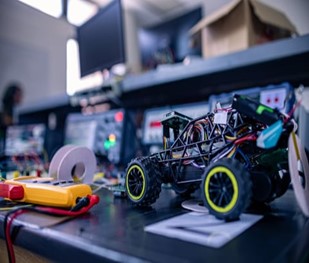
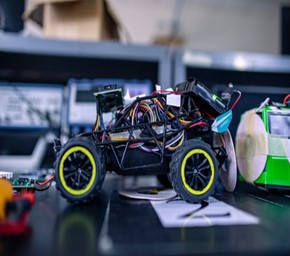
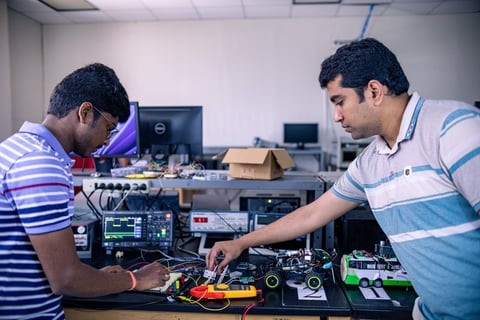
Cybersecurity Issues with Battery Energy Storage System
Integration of energy storage systems, such as grid scale battery energy storage system
(BESS) are essential to achieve quality power from the renewable energy resources
such as solar photovoltaic (PV) arrays and wind turbines. Our research focuses on
developing novel sophisticated controllers for the BESS that can address the intermittent
tendency of renewable generation sources. Alongside, keeping the virtual network architecture
of the modern smart grid in mind, we have devoted our resources to make these controllers
cyber resilient. We analyze the impacts of well-known cyber-attacks, such as the False
Data Injection (FDI) attack and Denial of Service (DoS) attack on the BESS controller
performance through MATLAB Simulation models. Moreover, we explore cyber-attack detection
and mitigation techniques using effective machine learning approaches.
Cybersecurity Issues in Electric Vehicle Charging System
Due to rising global warming concern, Government, private and public interests are
shifting towards mass adoption of electric vehicles (EVs). EVs have emerged as a sustainable
alternative to traditional internal combustion engines, offering reduced greenhouse
gas emissions and dependence on fossil fuels. As EV adoption rises, developing efficient
charging infrastructure has become crucial. Wireless charging systems have particularly
gained attraction due to their convenience and ease of use. However, integrating wireless
technology into EV charging introduces new security challenges, particularly in the
face of cyber-attacks. Cyberattacks targeting EV charging infrastructure can disrupt
operations, compromise user safety, and undermine public confidence in electric mobility.
Therefore, robust cybersecurity measures are urgently needed to protect wireless charging
systems from malicious activities. Vulnerabilities such as data manipulation, unauthorized
access, and denial-of-service attacks pose significant threats to the integrity and
reliability of charging operations. We are exploring novel means based on machine
learning and artificial intelligence to detect cyber-attacks and mitigate their adverse
impacts on the EV charging system.
Optimal Placement of Electric Vehicle Charging Station in Distribution Network
As the adaptation of Electric Vehicles (EVs) is increasing, the demand for strategical
placement of Electric Vehicle Charging Stations (EVCSs) is critical. Our research
focuses on the optimal placement of EVCS in active distribution grid by reducing the
transmission losses & maintaining the efficiency of the power grid. We are Implementing
the Artificial Hummingbird Algorithm (AHA) to determine the optimal bus locations
of the EVCSs in different standard IEEE benchmark systems, aiming to balance the load
and reduce the transmission losses. This method enhances the power grid performance
& promotes the sustainable growth of EV infrastructure. Another area of interest is
to work on multi-objective AHA, that accounts for the factors beyond transmission
losses, such as cost of installation, maintenance, environmental impact & user convenience.
This research is important for developing smarter grids that can handle multifold
increase of EVs without compromising on stability. The results of this research will
provide a blueprint for urban planners and policymakers to develop sustainable EVCS
network.
Mitigating Impacts of Increased Electric Vehicle Charging on Power Grids Using Cybersecure
Supercapacitor Energy Storage
The transition to electric vehicles (EVs) is crucial for reducing greenhouse gas emissions
and climate change. As more consumers and industries embrace EVs, the demand for efficient
and reliable charging infrastructure grows exponentially. However, this surge in EV
adoption places considerable strain on the existing power grid, resulting in issues
such as voltage drops, fluctuations, and overall grid instability. Our research focuses
on understanding and addressing these challenges by analyzing the impacts of increased
EV charging on the power grid. We aim to develop innovative solutions to mitigate
these issues through the integration of cybersecure intelligent control-based supercapacitor
energy storage system. These supercapacitors can provide rapid energy discharge and
recharge, helping to smooth out the peaks and valleys in electricity demand caused
by EV charging. By incorporating advanced cybersecurity measures, we ensure that these
energy storage systems are protected from potential cyber-attacks, which could otherwise
compromise grid stability.
Application of 5G and 6G Communication Systems to Smart Power Grids
5G is set to enable the future of the Internet of Things (IoT). Many applications,
including smart grid communication networks, require different bandwidth for uplink-downlink,
varying latency, and sometimes high connection density. 5G effortlessly meets these
diverse communication requirements within a single physical network. The 5G network
is barely commercialized with only few places enjoying its unparalleled benefits and
have taken a step forward to research on the upcoming wireless technologies. On the
research phase, the 6G network architecture will integrate novel network architectures
and technologies based on further evolution of the 5G network architecture. A 6G network
is defined as a cellular network that operates in untapped radio frequencies and uses
cognitive technologies like AI to enable high-speed, low-latency communication at
a pace multiple times faster than fifth-generation networks. As 6G networks are currently
under research and development, we are envisioning to implement it in our research.
Distributed Energy Resources
Distributed energy resources (DERs) are small-scale units of local power generation connected to the power grid at distribution level. The arrival of DER – a source of decentralized, community-generated energy – and its two-way flow of power is transforming the grid. DERs can include behind-the-meter renewable and non-renewable generation such as rooftop solar photovoltaic (PV) units, natural gas turbines, microturbines, wind turbines, fuel cells, battery energy storage, electric vehicles (EV) and EV chargers, controllable loads, and demand response applications. DERs may provide reliability during outages resulting from weather events, manage energy expenditures, meet customer desires to reduce their environmental footprint and/or support new evolving technologies. The impact of DERs on operating the power grid has been dramatic and exciting, resulting in both challenges and benefits to the entire grid spanning utilization, distribution, and transmission voltage ranges. Our research focuses on three major DERs such as PV, wind generator and energy storage systems. We are working on the development of intelligent control-based inverters and DC-DC choppers for the PV system. Moreover, development of a cost-effective wind turbine generator system aiming at increasing the power capacity of a wind generator is currently being investigated. Energy storage is an essential element to provide constant and smoothed power to the customers. Among several energy storage technologies, we are mainly focusing on the modeling and simulation of battery energy storage, supercapacitor energy storage, superconductive magnetic energy storage (SMES) and fuel cell systems. These energy storage devices are being integrated to the wind generator and PV power generation systems.
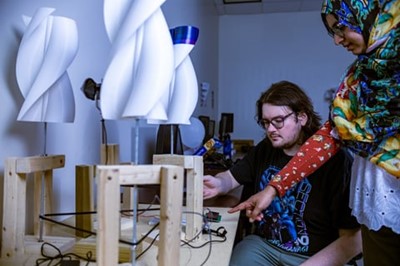
AC/DC Hybrid Microgrid Control
Hybrid AC/DC microgrids (HMGs) are becoming increasingly popular as they combine functionalities
and usefulness of both AC and DC microgrids to reduce frequent energy conversions
and to increase efficiency and reliability. Separate AC and DC microgrids have been
developing in different aspects of control, power management, design, and planning
over the past two decades. Although at the present time, AC microgrids are prevalent,
it is foreseen that AC and DC microgrids will commonly and efficiently be utilized
to interconnect energy resources and serve AC and DC loads at the distribution level.
Our research focuses on developing new control methods to augment the dynamic performance
of the hybrid microgrid system.
Load Forecasting and Scheduling for Smart Buildings
The load forecasting plays a pivotal role for buildings’ energy management system
to schedule, and control loads effectively while maintaining the reliability, stability
and quality of the utilized power within the buildings. Our research focuses on exploring
new methods based on data analytics, machine learning and artificial intelligence
for forecasting and scheduling of residential loads. We are particularly looking into
data-driven machine learning based new approach to estimate the PV capacity based
on predicted temperature, solar irradiance, humidity, heating degree days (HDD), cooling
degree days (CDD), etc. Moreover, equation-based new prediction models for the loads
are being implemented.
Effects of Geomagnetically Induced Current (GIC) on Power Transformers
Geomagnetically induced current (GIC) is a naturally occurring phenomenon initiated
by solar activity. Sunspots (relatively cool areas shielded by complex magnetic fields)
can give rise to solar flares and coronal mass ejections (CMEs). The CME carries its
own currents and magnetic fields that can affect the Earth’s magnetic field. Charged
particle movement in the conductive ionosphere increases the current flows in the
electrojets, which are currents in the order of millions of amperes located more than
100 km above the Earth’s surface. These electrojet currents induce quasi-dc voltages
in transmission lines that, in turn, drive the flow of GIC s wherever there is a path
for them to flow. In power systems, GICs are quasi-dc currents and consequently cause
saturation of transformers. This in turn results in a nonlinear operation of the transformer
and in a significant increase of the exciting current. All this may then lead to the
generation of harmonics in the electricity, unnecessary relay tripping, increased
reactive power demands, voltage fluctuations and drops, and even a black-out of the
whole system. Transformers may be overheated and, in the worst case, be permanently
damaged. Our research focuses on exploring new means to minimize the adverse effects
of GIC on power transformers.
Research Facilities
The EPES Lab is equipped with the latest computers to perform research. The MATLAB/Simulink software is available in all the computers. The students have the scope to perform hardware-based research also. The Lab has an indoor solar power set up that includes 4 panels, MPPT controller, charge controller, inverter, and battery storage system. Also, there are two small protypes for the dynamic wireless charging of electric vehicle system. A small wind turbine generator prototype is available at the lab. Moreover, the Lab members have access to a solar powered 5G-enabled IoT based electric vehicle charging infrastructure located at the South Campus of the university. In addition, the Lab members can access to the Energy Conversion Laboratory of the ECE Department, which is equipped with the modern generators, motors, transformers, wind turbine and photovoltaic trainer, smart grid electrical generation trainer, various meters, oscilloscopes, etc.
|
Smart Grid Electrical Generation Trainer |
Wind Turbine and Photovoltaic Trainer |

